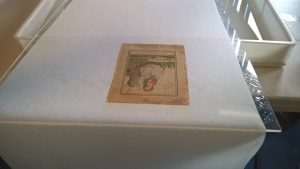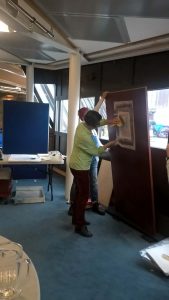This week’s blog post comes from Special Collections Conservator, Emily, who recently attended a conservation training workshop in Edinburgh…
Earlier this year in September, I attended a two-day course organised by Helen Creasy from the Scottish Paper Conservation Studio and hosted by the National Library of Scotland entitled ‘Paper and Water: Conservation Principles’. The course was based on the book “Paper and Water: a Guide for Conservators” (Banik and Brückle), which has become an essential text for conservators since its publication in 2011, and provided by Doris Müller-Hess and Hildegard Homburger, private conservators from Vienna and Berlin, respectively.
This course examined the interaction between cellulose and water and the effect this has during conservation treatments. Paper conservators frequently use treatments that employ water, from simple treatments repairing a document using wheat starch paste, and using a poultice to remove historic repairs, to more complex treatments such as washing paper to reduce discolouration and acidity in the paper, so it is vital to understand this complex relationship.

Paper and Water: Conservation Principles
Each day began with theoretical lectures, followed by practical demonstrations in the afternoon. On the first day, we learnt about the properties of cellulose and water and how they interact on a molecular level, with a focus on humidification and washing. In the afternoon, humidification and washing techniques linked to the principles learnt in the morning were demonstrated. Items were humidified using a Gortex and Sympatex sandwich, and then washed using two different techniques – a damp blotter, and a viscose non-woven fabric called Paraprint. Washing paper objects on Paraprint is a relatively new technique which utilises the capillary action of the material to transport the water up a slope. Discolouration products are solubilised by the moisture and removed from the paper using the capillary forces. This technique can be used to wash objects with water-sensitive media.

Item washing on Paraprint
The quality of water and the advantages and disadvantages of the various methods of water purification were discussed on the second day. This was followed by a description of the paper manufacturing and drying process. Understanding how paper is made and dried helps to explain how paper will react when it comes in contact with moisture again. To show this in practice, different drying techniques were demonstrated, including the Japanese technique of drying on a kari-bari board.

Demonstration of drying on a kari bari board
This course helped to consolidate my understanding of the relationship between paper and water, and introduced me to new conservation techniques. It was also great to meet with other conservators who attended from throughout the UK and Europe. I would definitely recommend it to other paper conservators.
